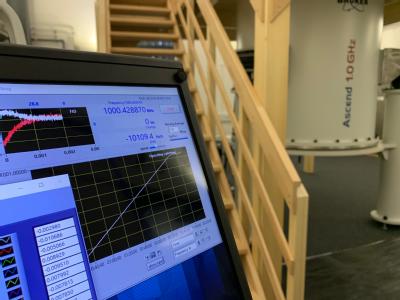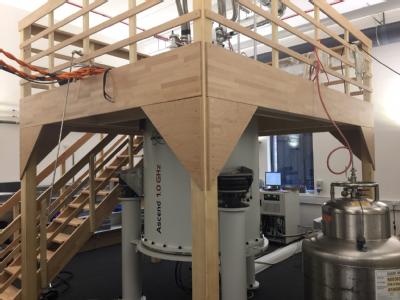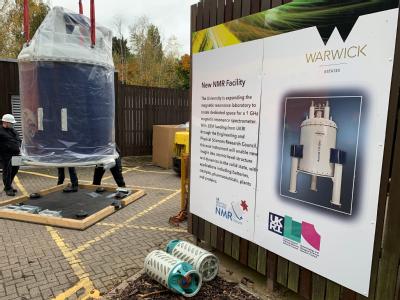Highest magnetic field for Nuclear Magnetic Resonance in the UK achieved at University of Warwick
- New 1 GHz solid-state Nuclear Magnetic Resonance (NMR) spectrometer is now at field at University of Warwick
- Latest addition to suite of NMR technology at the EPSRC- and BBSRC-funded National Research Facility for High-Field Solid-State NMR
- Will provide new insights that will benefit a wide range of industries, including pharmaceuticals, energy, batteries, materials and life sciences
 Scientists will soon have access to a powerful 1 GHz magnetic field to analyse the structure and dynamics with atomic resolution for a wide variety of systems across chemistry, and life and materials science in the UK for the first time, as a new high-powered magnet for Nuclear Magnetic Resonance (NMR) in the UK has been successfully been energized at the University of Warwick.
Scientists will soon have access to a powerful 1 GHz magnetic field to analyse the structure and dynamics with atomic resolution for a wide variety of systems across chemistry, and life and materials science in the UK for the first time, as a new high-powered magnet for Nuclear Magnetic Resonance (NMR) in the UK has been successfully been energized at the University of Warwick.
The UK’s first 1 GHz solid-state Nuclear Magnetic Resonance (NMR) spectrometer will soon be running experiments, following an energization process that involved cooling it to a mere two degrees above absolute zero.
Funded with £8 million from the Engineering and Physical Sciences Research Council (EPSRC), the new 1 GHz NMR instrument adds to the National Research Facility for High-Field Solid-State NMR based at the University of Warwick.
Potential applications for the new technology will include improved pharmaceutical formulations for drug delivery, as well as better quality materials for energy and catalysis.
Professor Steven Brown, from the University of Warwick Department of Physics and Director of the National Research Facility for High-Field Solid-State NMR, said: “It is great that the Bruker engineers have successfully brought the new 1 GHz magnet to field at the first attempt – this will be a fantastic resource for the UK scientific community.”
 “NMR is a very powerful technology that has driven scientific advances in a diverse range of applications. As a national facility we welcome researchers from UK universities to further their understanding of physical sciences, including pharmaceutical formulation and drug delivery, and energy and materials science, as well as life sciences, such as protein interactions and plant biomass.
“NMR is a very powerful technology that has driven scientific advances in a diverse range of applications. As a national facility we welcome researchers from UK universities to further their understanding of physical sciences, including pharmaceutical formulation and drug delivery, and energy and materials science, as well as life sciences, such as protein interactions and plant biomass.
“We are delighted that UK researchers will be able to benefit from this leading-edge NMR technology, which will stimulate new research in many different fields of application.”
Patrick Wikus, who is managing Bruker’s GHz-class NMR program, added: “We are very happy that the energization of the 1.0 GHz NMR magnet at the University of Warwick went smoothly. Reaching full field is a key milestone in a GHz-class spectrometer installation. Our engineers will now proceed with the homogenization of the magnet, and then continue with the installation of a number of NMR probes which will support the various research tasks that are planned. We look forward to seeing the exciting results the UK scientific community will undoubtedly achieve with this new instrument.”
 Nuclear Magnetic Resonance uses powerful magnetic fields to provide valuable insight into atomic-scale structure, disorder and dynamics of complex systems. The University of Warwick houses the largest solid-state NMR facility in the UK, equipped with NMR technology ranging from 100 to 700 MHz, as well as the National Research Facility’s existing 850 MHz spectrometer. The national Research Facility is available for use by scientists at UK universities, research organisations and in industry, with previous research encompassing wide-ranging research areas such as pharmaceuticals, battery research and energy materials.
Nuclear Magnetic Resonance uses powerful magnetic fields to provide valuable insight into atomic-scale structure, disorder and dynamics of complex systems. The University of Warwick houses the largest solid-state NMR facility in the UK, equipped with NMR technology ranging from 100 to 700 MHz, as well as the National Research Facility’s existing 850 MHz spectrometer. The national Research Facility is available for use by scientists at UK universities, research organisations and in industry, with previous research encompassing wide-ranging research areas such as pharmaceuticals, battery research and energy materials.
The new 1 GHz NMR instrument will enable more PhD researchers from across the country to be trained in a variety of disciplines with the most advanced equipment. Crucial high-end industrial research in sectors such as pharmaceuticals and catalysis will also benefit greatly.
Funding for the new spectrometer was coordinated by EPSRC and also comes from three other research councils: BBSRC, MRC and NERC, who have supported this funding of high-field NMR infrastructure in the UK.
Andrew Wright, Head of Programme, Capital Infrastructure, and John Hand, Head of Programme, Physical Sciences, of the Engineering and Physical Sciences Research Council said: “EPSRC is committed to providing the analytical sciences community with the resources it requires to continue world leading research in UK universities.
“This NMR system will be of enormous benefit not only to a wide range of engineering and physical sciences researchers, but also those in bioscience, medical and environmental science.”
Ends
Notes to editors:
Photographs available to download:
Console display showing the new NMR spectrometer (in the background) generating a 1 GHz magnetic field:
https://warwick.ac.uk/services/communications/medialibrary/images/november_2020/img_8330.jpg
The new 1 GHz solid-state Nuclear Magnetic Resonance (NMR) spectrometer in position at the National Research Facility for High-Field Solid-State NMR based at the University of Warwick:
https://warwick.ac.uk/services/communications/medialibrary/images/november_2020/1.jpg
https://warwick.ac.uk/services/communications/medialibrary/images/november_2020/9a.jpg
The new NMR spectrometer arrives on site.
https://warwick.ac.uk/services/communications/medialibrary/images/november_2020/103.jpg
https://warwick.ac.uk/services/communications/medialibrary/images/november_2020/112.jpg
17 November 2020
University of Warwick press office contact:
Peter Thorley
Media Relations Manager (Warwick Medical School and Department of Physics) | Press & Media Relations | University of Warwick
Email: peter.thorley@warwick.ac.uk
Mob: +44 (0) 7824 540863
